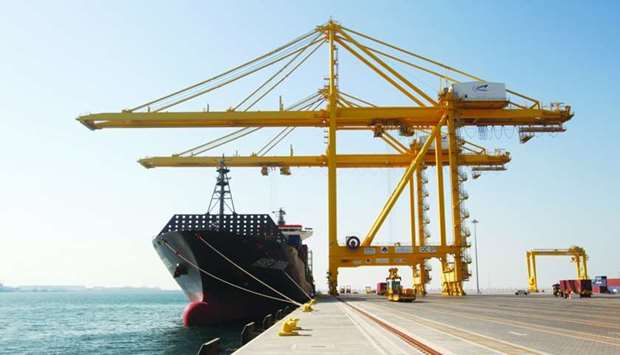Qatar witnessed strong container traffic (net tonnage) growth year-on-year in July 2019 with Ras Laffan and Hamad ports together accounting for about 78% of the total maritime traffic, according to the official estimates.
The container traffic through Qatar ports more than doubled year-on-year to 11.74mn tonnes in July this 2019, said the data released by the Planning and Statistics Authority in its latest monthly bulletin. On a monthly basis, the net tonnage witnessed about 4% decline.
The number of vessels calling on Qatar ports stood at 747, which registered 26% and 7.5% expansion on annual and monthly basis respectively in July this year.
Ras Laffan Port berthed 245 vessels in July 2019. The net tonnage through the port was 6.16mn, accounting for more than 52% of the total container traffic in the country's ports.
Ras Laffan Port has been designed and purpose built primarily as the export facility for liquefied natural gas, liquid petroleum gas, condensates, petroleum products and sulphur derived from the processing of gas landed from the North Field gas reservoir.
Hamad Port, which has seen the world’s largest shipping companies seek entry and growth in the Qatari and regional markets, berthed 141 vessels in July 2019, which saw more than 1% growth month-on-month but fell more than 5% year-on-year.
The container traffic stood at 2.94mn tonnes in July, which recorded 15% and 5.7% expansion on yearly and monthly basis respectively.
Hamad Port’s strategic geographical location offers opportunities to create cargo movement towards the upper Gulf, supporting countries such as Kuwait and Iraq, and south towards Oman, QTerminals chief executive Neville Bissett had earlier said.
In July 2019, total exports (free on board) of goods (including exports of goods of domestic origin and re-exports) grew about 2% on a monthly basis but showed a 16% decline on a yearly basis. Qatar's total imports (valued at cost insurance and freight) showed a 13% growth month-on-month but 6% fall on a yearly basis.
Al Ruwais Port saw 230 vessels berthed in July 2019, which registered more than 26% surge month-on-month; while it had seen a 15% decline year-on-year. On a monthly basis, the port saw 14% growth in container traffic to 35,000 tonnes.
On a yearly basis, it witnessed more than 11% slump. Besides the usual handling of general cargoes, the port is now handling the increased demand of foodstuff and other commodities. Al Ruwais port provides a ready solution by acting as gateway for fresh commodities from neighbouring countries.
Mesaieed Port berthed 119 vessels in July, which showed 7% growth month-on-month and the net tonnage showed more than 12% expansion to 2mn tonnes. On a yearly basis, the number of vessels fell 21% and container traffic by about 13%.
Haloul Port saw as many as six vessels berthed in July this year against seven the previous month. The net tonnage through the port, however, saw more than 5% decline to 593,000 tonnes. On a yearly basis, vessels berthed declined more than 14% ad container traffic by 18%.
Doha Port berthed six vessels this July, showing 20% growth month-on-month. The container traffic grew about 7% to 13,000 tonnes in the review period.




